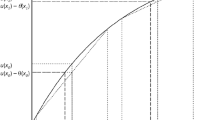Abstract
The degree of downside risk aversion (or equivalently prudence) is so far usually measured by \(\frac{-U^{\prime \prime \prime }}{U^{\prime \prime }}\). We propose here another measure, \(\frac{U^{\prime \prime \prime }}{U^{\prime }}\), which has specific and interesting local and global properties. Some of these properties are to a wide extent similar to those of the classical measure of absolute risk aversion, which is not always the case for \(\frac{ -U^{\prime \prime \prime }}{U^{\prime \prime }}\). It also appears that the two measures are not mutually exclusive. Instead, they seem to be rather complementary as shown through an economic application dealing with a simple general equilibrium model of savings.
Similar content being viewed by others
Notes
The other is related to the degree of absolute risk aversion. See their Eq. 7 and its discussion.
Provided the two risks have the same mean and variance.
Of course many other forms of compensations are possible. They lead basically to the same result after sometimes less transparent developments.
The relationship between skewness and the third derivative of U has been discussed in many papers. A list of such papers can be found in Scott and Horvath (1980).
Notice that a similar approach is used by Foncel and Treich (2005) to analyse the concept of fear of ruin developed by Aumann and Kurz (1977) and which is equal to \(\frac{U}{U^{\prime }}\). Besides, in a recent and innovative paper based on comparative statics properties, Jindapon and Neilson (2007) present the Ross’ equivalent of prudence through the division of U ″′ by U ′.
See especially their Corollary 3.4.
s ″′ > 0 is sufficient but not necessary to yield the result.
By limiting ourselves to cubic utility we do not introduce effects of higher orders such as temperance or edginess that affect also the equilibrium value of r. As correctly pointed out by the referee, a similar conclusion can be reached by taking a second order approximation of the expected utility term in Eq. 7 and then taking its derivative with respect to c 1 evaluated at c 1 = y 1.
For a random variable \(\widetilde{x}\): \(\mu _{3}=E(\widetilde{x}-\mu )^{3}\).
References
Aumann, Robert and Mordecai Kurz. (1977). “Power and Taxes,” Econometrica 45(5), 1137–1161.
Arrow, Kenneth. (1965). Aspects of the Theory of Risk-bearing. Helsinki: Yrjš Jahnsson Foundation.
Barsky, Robert. (1989). “Why Don’t the Prices of Stocks and Bonds Move Together?” American Economic Review 79, 1132–1145.
Diamond, Peter and Joseph Stiglitz. (1974). “Increases in Risk and in Risk Aversion,” Journal of Economic Theory 8(3), 335–360.
Eeckhoudt, Louis and Harris Schlesinger. (2006). “Putting Risk in its Proper Place,” American Economic Review 96(1), 280–289.
Eeckhoudt, Louis and Harris Schlesinger. (1994). “A Precautionary Tale of Risk Aversion and Prudence.” In B. Munier and M. Machina (eds), Models and Experiments in Risk and Rationality 75–90, Dordrecht: Kluwer Academic Publishers.
Foncel, Jérôme and Nicolas Treich. (2005). “Fear of Ruin,” The Journal of Risk and Uncertainty 31(3), 289–300.
Friedman, Milton and Leonard Savage. (1948). “The Utility Analysis of Choices Involving Risk,” Journal of Political Economy 56(4), 279–304.
Gollier, Christian and John Pratt. (1996). “Risk Vulnerability and the Tempering Effect of Background Risk,” Econometrica 64(5), 1109–1123.
Jindapon, Paan and William Neilson. (2007). “Higher-order Generalizations of Arrow–Pratt and Ross Risk Aversion: A Comparative Statics Approach,” Journal of Economic Theory 136(1), 719–728.
Keenan, Donald and Arthur Snow. (2005). “Greater Downside Risk Aversion,” The Journal of Risk and Uncertainty 24(3), 267–277.
Kimball, Miles. (1990). “Precautionary Saving in the Small and in the Large,” Econometrica 58(1), 53–73.
Modica, Salvatore and Marco Scarsini. (2005). “A Note on Comparative Downside Risk Aversion,” Journal of Economic Theory 122, 267–271.
Menezes, Carmen, C. Geiss and John Tressler. (1980). “Increasing Downside Risk,” American Economic Review 70(5), 921–932.
Pratt, John. (1964). “Risk Aversion in the Small and in the Large,” Econometrica 32, 122–136.
Ross, Stephen. (1981). “Some Stronger Measures of Risk Aversion in the Small and the Large with Applications,” Econometrica 49(3), 621–638.
Scott, Robert and Philip Horvath. (1980). “On the Direction of Preference for Moments of Higher Order than the Variance,” The Journal of Finance 35(4), 915–919.
Acknowledgements
The authors thank Christian Gollier, Patrick Roger, Harris Schlesinger, Fred Schroyen, Arthur Snow, the editor and an anonymous referee for very helpful comments and suggestions.
Author information
Authors and Affiliations
Corresponding author
Appendix
Appendix
Consider first the lottery \(\widetilde{z}\) on the LHS of Eq. 1 i.e.

where \(E(\,\widetilde{\varepsilon }\,)=0\). Denoting by σ 2 and μ 3 respectively the variance and the skewnessFootnote 10 of \(\widetilde{\varepsilon }\), we find after easy manipulations:
Consider now the lottery \(\widetilde{y}\) on the RHS of Eq. 1 i.e.

One easily obtains:
Of course the lotteries \(\widetilde{z}\) and \(\widetilde{y}\) have the same mean and variance. Yet they do not have the same skewness and going from \( \widetilde{y}\) to \(\widetilde{z}\) increases skewness by \(\frac{3}{2}\sigma ^{2}k\). Such an increase in skewness is positively appreciated by individuals with U ″′ > 0 and we observe that in Eq. 5 the degree of D.R.A. (\(\frac{U^{\prime \prime \prime }(x)}{ U^{\prime }(x)}\)) is multiplied by a term that is proportional to the change in skewness to obtain m. Hence skewness is implicitly present in Eq. 5.
Rights and permissions
About this article
Cite this article
Crainich, D., Eeckhoudt, L. On the intensity of downside risk aversion. J Risk Uncertainty 36, 267–276 (2008). https://doi.org/10.1007/s11166-008-9037-x
Published:
Issue Date:
DOI: https://doi.org/10.1007/s11166-008-9037-x



